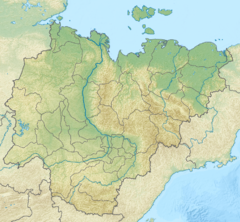|
Arga-Yuryakh (Rassokha)
The Arga-Yuryakh (Russian: Арга-Юрях; Yakut: Арҕаа Үрэх, Arğaa Ürex) is a river in Sakha Republic (Yakutia), Russia. It is a tributary of the Rassokha of the Alazeya basin. The river has a length of 312 kilometres (194 mi) and a drainage basin area of 5,600 square kilometres (2,200 sq mi).[1] The river flows north of the Arctic Circle, across desolate tundra territories of the East Siberian Lowland. Its basin falls within Srednekolymsky District.[2] The name of the river comes from the Yakut "Arğaa-ürex" (Арҕаа-үрэх), meaning "western river".[3] CourseThe Arga-Yuryakh has its sources at the confluence of the 21 km (13 mi) long Zeya and the 20 km (12 mi) long Taba-Bastaakh in the southern slopes of the Ulakhan-Sis. It flows roughly southwards away from the range, first following its southern flank eastwards, then bending southwards into a region of lakes of the Kolyma Lowland. The river meanders strongly, heading southeastwards across the vast lake area. Finally it meets the left bank of the northward flowing Ilin-Yuryakh. The confluence of both rivers forms the Rassokha, the largest tributary of the Alazeya.[2][4] TributariesThe main tributaries of the Arga-Yuryakh are the 126 km (78 mi) long Achchygyi-Yurekh (Аччыгый-Юрэх) on the right, as well as the 62 km (39 mi) long Ot-Yurekh and the 50 km (31 mi) long Kusagan-Yurekh on the left.[1] The river is frozen between late September or early October and late May or early June. The Arga-Yuryakh is fed by snow, rain and ice. The river basin is marked by permafrost, swamps and lakes, the lake surface taking 15.2 % of the total basin area.[5] See alsoReferences
External links
|
||||||||||||||||||||||||||||||||||

